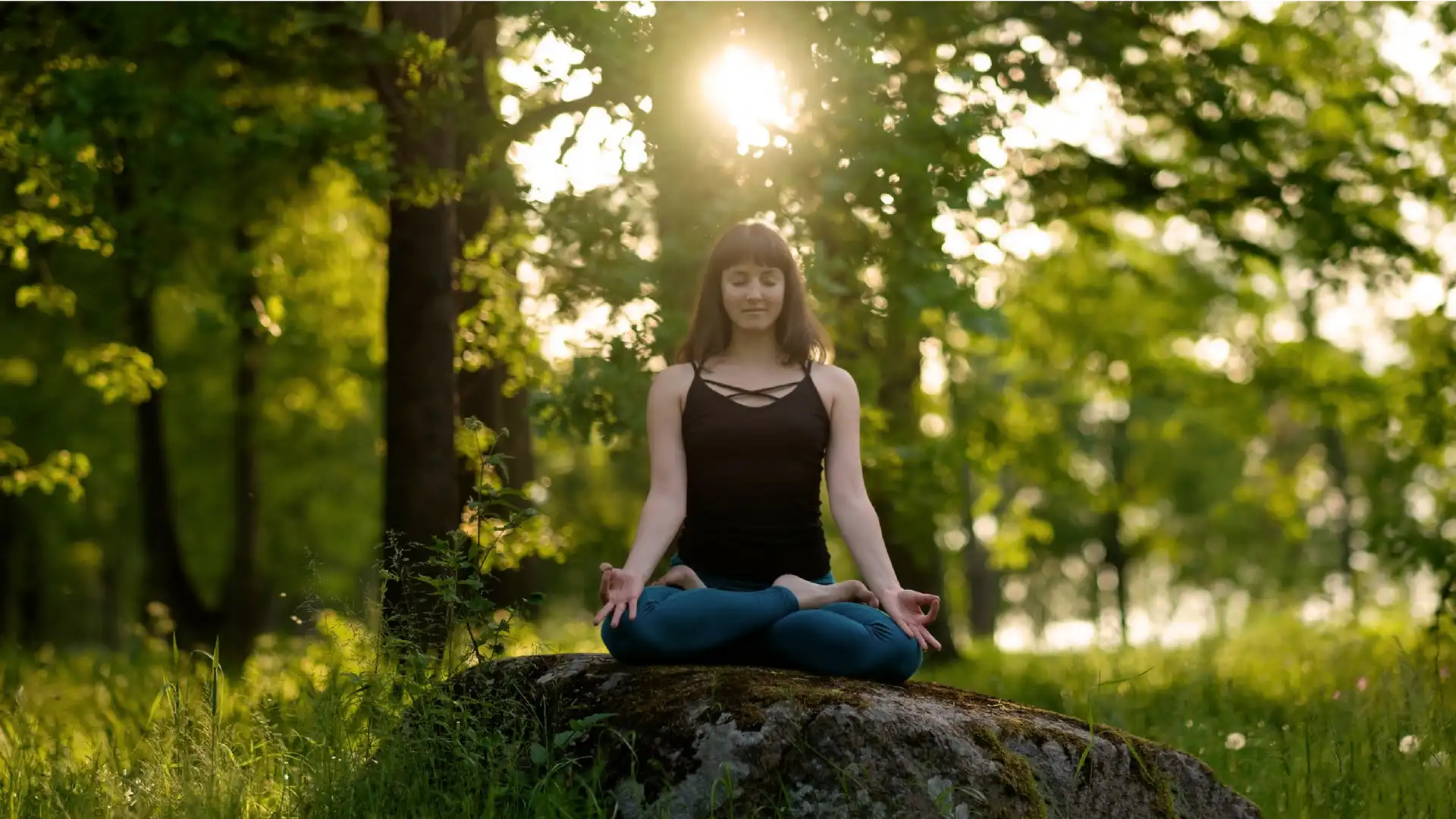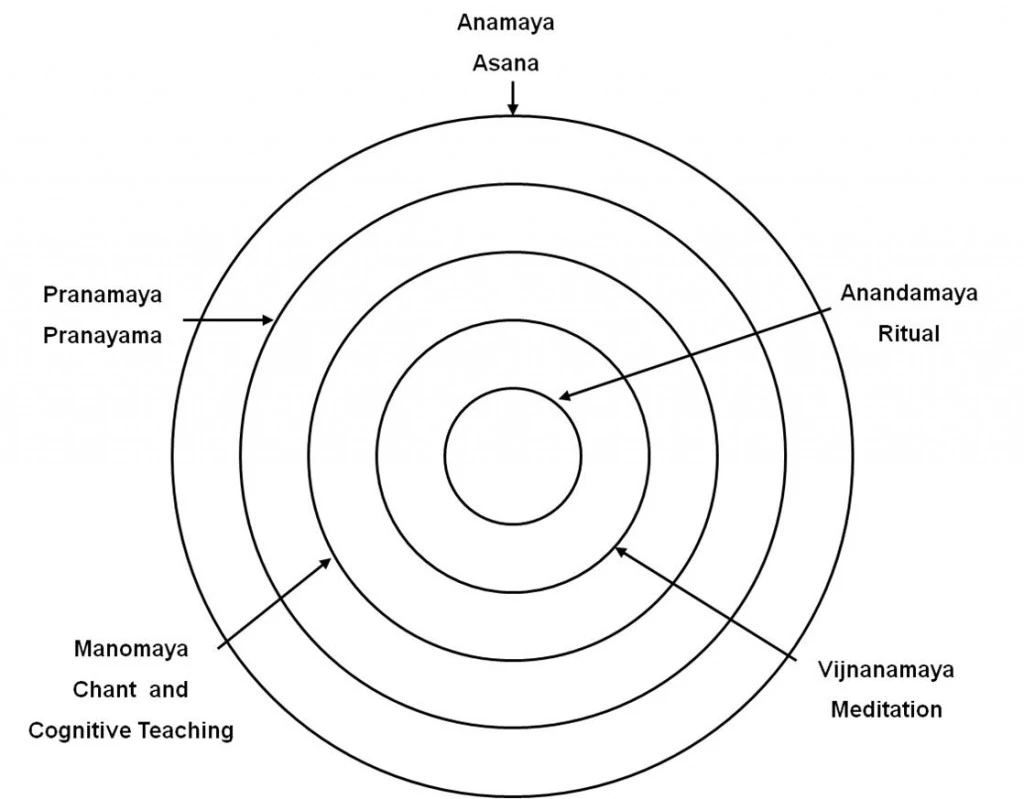Yoga for the Whole Being: The Panchamaya Koshas and the 5 Levels of Practice

My yoga teacher often jokes about what he calls the “reductionism of yoga in America.” He says that in India, yoga is a system of complete physical, mental and spiritual health. When yoga was brought to America, however, practitioners latched on to asana, the physical postures of yoga. Then as time went on, they focused on the stretching aspects of asana, instead of the full energetic, stretching, balancing, and strengthening effects. Then, he continues, with the common focus on form, it became about locking the knees and focusing on the hamstrings. So, he jokes, yoga in America has been reduced to stretching your hamstrings.
Like most jokes, this is likely an oversimplification. But he has a valid point. Look at any article on yoga and you will see people performing postures as if those postures were the only component of yoga. In reality, yoga is comprised of many tools, only one of which is asana.
The Panchamaya Model
This model describes the full breadth of yoga practices and how they can impact every level of the human system. It progresses from the most gross, or tangible level, to the most subtle, or intangible one. Work on one level may show up in another, but the tool associated with that level is the one most likely to have a direct impact on that level.

Panchamaya Model Diagram
- Anamaya: This level comprises the “food” body, including the muscles, bones, ligaments, etc. of our bodies. Not surprisingly, the yoga tool we use to impact this level is asana. So when I teach my “yoga for healthy backs” class, for example, we primarily focus on yoga movements that can help heal the students’ structural issues.
- Pranamaya: This level comprises the “energy” body. It includes physiological systems, such as the respiratory system, as well as the energy of emotions. The tool most targeted for this level is pranayama or breath work. That’s why I use the breathing practices to help with insomnia. Although asana can help, breathing is the more powerful and targeted tool for these issues.
- Manomaya: This is the level of intellect. This may be a stretch for some Westerners, but the tool used to increase intellect in the traditional teachings is sound or chanting. In the West, we tend to use reading and lecture to access our intellects. When the yogic models were developed, there were no printing presses, so knowledge was passed down orally from generation to generation. In India, they still use chant to help improve cognitive function in many populations, including the aging and children with learning issues.
- Vijnanamaya: This is the level of personality, or character. The yoga tool we use to impact character is meditation. I personally believe all meditation techniques are valid. But in this lineage, we practice self-exploratory mediations that help us learn more about ourselves and how we react to what we experience. Meditation is a key part of my yoga classes for anxiety and depression.
- Anandamaya: This is the level of joy or spirit. It is impacted via ritual. I have a hard time describing ritual, except that it is a combination of other practices done in a symbolic way. We use ritual in the West as well. Think, for example, of weddings, graduations, etc. I personally use ritual to mark the beginning and end of every class by ringing chimes and saying “namaste.” I do this to help connect with my students in a symbolic way.
So the next time someone asks you about yoga, remember that the postures that come to mind are really only the tip of the iceberg. This wonderful tradition offers so much more!
Would you like to delve deeper into this topic? Study with YogaUOnline and Kristine Kaoverii Weber – The 5 Levels of Health: Ancient Insights into Health and Well-being.
Reprinted with permission from Whole Life Yoga.
Tracy Weber, E-RYT 500, C-IAYT is the owner of Whole Life Yoga in Seattle as well as the creator and director of Whole Life Yoga’s teacher training program. A practicing yoga therapist, she is also the author of the Downward Dog Mystery series, which won the Maxwell award for fiction. She loves sharing her passion for yoga and animals in any way possible.
Tracy and her husband Marc live in Seattle with their crazy new German shepherd pup, Ana. When she’s not writing, Tracy spends her time teaching yoga, trying to corral Ana, and sipping Blackthorn cider at her favorite ale house.
For more information on Tracy and the Downward Dog Mysteries, visit her author website: http://TracyWeberAuthor.com/.



